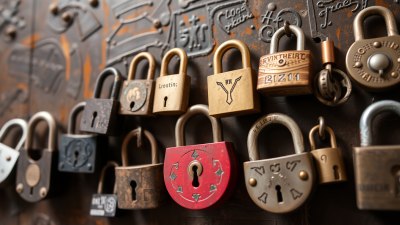Building a Collection of Local Vintage Locks from Markets
Discover tips on how to build an impressive collection of vintage locks from local markets.

Image created with Flux Schnell
Building a collection of vintage locks can be an exciting and rewarding hobby that intertwines history, craftsmanship, and the thrill of the hunt. For enthusiasts, local markets serve as treasure troves filled with unique antiques that tell stories of their past. In this guide, we will explore strategies for collecting vintage locks at local markets, understanding their historical significance, identifying various types, and maintaining your collection.
Understanding Vintage Locks
Vintage locks, much like other antiques, have a rich history that reflects the technological and artistic trends of their time. By understanding key aspects of vintage locks, collectors can enhance their knowledge and appreciation for their collection. Locks have evolved significantly from simple mechanical designs to more sophisticated security measures. Collecting these pieces allows enthusiasts to explore different eras and craftsmanship styles.
Types of Vintage Locks
Before diving into local markets, it’s crucial to familiarize yourself with the various types of vintage locks available. Some categories include:
- Padlocks: Used for securing gates, luggage, and more. They come in various shapes and sizes.
- Keyhole Locks: Featuring a keyhole for insertion of a key, often seen in doors and cabinets.
- Combination Locks: Require a specific sequence of numbers or symbols for opening.
- Brass Locks: Known for their durability and attractive appearance, often found in historical homes.
Researching Local Markets
When building a collection, the first step is identifying local markets that specialize in antiques or vintage items. Research online for antique shops, flea markets, estate sales, and garage sales in your community. Joining local collector groups or forums can also provide insights into where to find vintage locks. Planning your visits ahead of time will allow you to maximize your opportunities for discovering unique pieces.
What to Look For
When attending local markets, it’s important to know what to look for in vintage locks. Start by examining the overall condition of the lock. Check for rust, damage, or missing parts. While minor wear can add character, significant damage can affect the value.
Next, observe the design and markings. Manufacturer names, patent dates, and unique designs can greatly enhance the value of a lock. Always carry a magnifying glass to inspect intricate details. Undoubtedly, the more knowledge you have about historical and rare locks, the better equipped you will be to make informed purchases.
Negotiating Prices
One of the exciting aspects of buying vintage locks at local markets is the potential for negotiation. When you spot a lock that interests you, it’s advisable to start with a friendly conversation with the seller. Inquire about the history of the lock, which may help you gauge its value.
Once you establish rapport, feel free to discuss pricing. Sellers often appreciate an informed buyer who shows genuine interest in the item. As a rule of thumb, having a strong understanding of the market value will give you leverage during price negotiations.
Building Your Collection Step by Step
When curating your collection of vintage locks, start small and gradually expand. Focus on specific types, eras, or styles that capture your interest. Keeping track of your collection is also essential. Consider creating an inventory by documenting each lock’s type, manufacturer, year, condition, and any additional history you uncover during your research.
As you continue to build your collection, consider developing a display strategy. Properly displaying your vintage locks not only showcases your hard work but also protects your items from damage. Shadow boxes, glass cabinets, or dedicated shelves can be practical solutions for creating an eye-catching display.
Caring for Your Collection
Consider using silica gel packets or dehumidifiers in your display area to prevent moisture buildup that can cause rust. If you plan to store your locks for long periods, ensure they are kept in a dry and clean environment to minimize deterioration.
Networking with Other Collectors
Another enriching aspect of collecting vintage locks is connecting with fellow enthusiasts. Join online forums or attend local collector meetups. Engaging with a community of collectors can provide valuable insights, tips, and opportunities for trading or purchasing unique locks.
Always remember that collecting is as much about the journey as it is about the final collection. The stories and connections made along the way will add depth to your hobby and enrich your experience.
Documenting Your Findings
For serious collectors, documenting your finds and stories behind each lock can enhance the narrative of your collection. Consider creating a digital or physical scrapbook where you can include images, notes on historical context, and anecdotes about each purchase. This documentation can also serve as a reference for future sales or trades.
Exploring Online Marketplaces
While local markets are fantastic, don’t overlook the potential of online marketplaces. Websites like eBay, Etsy, and specialized antique marketplaces provide opportunities to purchase vintage locks beyond your local area. However, ensure you carefully assess the seller’s credibility, product descriptions, and return policies before making a purchase.
Expanding Your Knowledge
Continuously expanding your knowledge about vintage locks will not only enhance your collection but will also make you a more discerning buyer. Consider reading books on lock history and collecting or attending workshops focused on locksmithing and collection methods. Museums and historical exhibitions may offer insights that illuminate the significance of the locks in your collection.
Building a collection of local vintage locks from markets can be an exhilarating experience filled with adventure and discovery. With thoughtful research, a passion for history, and a keen eye for unique finds, you can successfully curate a collection that reflects the artistry and craftsmanship of past civilizations. Embrace the journey, connect with fellow collectors, and enjoy every step as you unlock the fascinating world of vintage locks.











